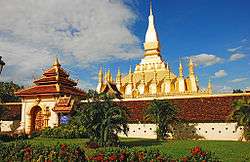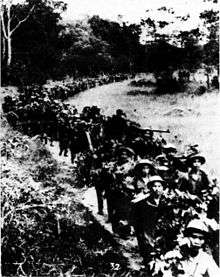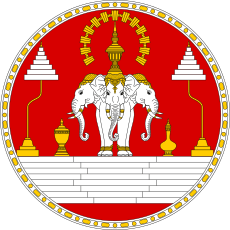Kingdom of Laos
| Kingdom of Laos | ||||||||||||||
| ພຣະຣາຊອານາຈັກລາວ Phra Ratxa A-na-chak Lao Royaume du Laos | ||||||||||||||
| French protectorate (1947–1953) | ||||||||||||||
| ||||||||||||||
| ||||||||||||||
| Anthem Pheng Xat Lao | ||||||||||||||
 | ||||||||||||||
| Capital | Vientiane (administrative) Luang Phabang (royal) | |||||||||||||
| Languages | Lao | |||||||||||||
| Government | Constitutional monarchy | |||||||||||||
| King | ||||||||||||||
| • | 1947–1959 | Sisavang Vong | ||||||||||||
| • | 1959–1975 | Savang Vatthana | ||||||||||||
| Prime Minister | ||||||||||||||
| • | 1962–1975 | Souvanna Phoumaa | ||||||||||||
| History | ||||||||||||||
| • | Autonomy | 11 May 1947 | ||||||||||||
| • | Independence | 22 October 1953 | ||||||||||||
| • | Communist takeover | 23 August 1975 | ||||||||||||
| • | Lao PDR established | 2 December 1975 | ||||||||||||
| Area | 236,800 km² (91,429 sq mi) | |||||||||||||
| Population | ||||||||||||||
| • | est. | 3,100,000 | ||||||||||||
| Density | 13.1 /km² (33.9 /sq mi) | |||||||||||||
| Currency | Kip | |||||||||||||
| ||||||||||||||
| Today part of | | |||||||||||||
| a. | Several times. | |||||||||||||
Part of a series on the |
||||||||||||
|---|---|---|---|---|---|---|---|---|---|---|---|---|
| History of Laos | ||||||||||||
 | ||||||||||||
| Lan Xang Era | ||||||||||||
|
||||||||||||
| Regional Kingdoms Era | ||||||||||||
|
||||||||||||
| Colonial Era | ||||||||||||
|
||||||||||||
| Modern Era | ||||||||||||
|
||||||||||||
| See also | ||||||||||||
The Kingdom of Laos was a constitutional monarchy that ruled Laos beginning with its independence on 9 November 1953. The monarchy survived until December 1975, when its last king, Savang Vatthana, surrendered the throne to the Pathet Lao, who abolished the monarchy in favor of a Marxist state called the Lao People's Democratic Republic, which has controlled Laos since.[1]
Given self-rule with the new Constitution in 1947 as part of a federation with the rest of French Indochina,[2] the 1953 Franco-Lao Treaty finally established a sovereign, independent Laos, but did not stipulate who would rule the country. In the years that followed, three groups led by the so-called Three Princes, contended for power: the neutralists under Prince Souvanna Phouma, the right-wing party under Prince Boun Oum of Champassak, and the left-wing, North Vietnamese-backed Lao Patriotic Front (now called the Pathet Lao) under Prince Souphanouvong and future Prime Minister Kaysone Phomvihane.
History
The Kingdom of Laos was officially proclaimed when the new Constitution was promulgated in 1947, as part of the colonial French Union,[2] and obtained full independence in 1953.
Government
Following the Franco-Lao Treaty of 1953, which gave Laos independence, the Royal Lao Government took control of the country. This treaty established a constitutional monarchy, with Sisavang Vong as King and Prince Souvanna Phouma as Prime Minister.
Many attempts were made by the Three Princes and King Sisavang Vatthana to establish a coalition government. The First Government of National Unity was established in 1958 under Prince Souvanna Phouma, but collapsed after two months. The Prime Minister, who under the constitution appointed his ministers and received advice from the King, made a deal with his brother Prince Souphanouvong.
Souvanna Phouma gave the Communists two seats in the Cabinet, and in return Souphanouvong would integrate 1,500 of his 6,000 Communist troops into the royal army. Prince Souphanouvong was given the post of Minister of Planning, Reconstruction and Urbanization, while another member of the Communist Party was named Minister of Religion and Fine Arts.
Military
The Kingdom of Laos was divided into five military regions. The Royal Lao Armed Forces were responsible for the defense of the country, comprising three branches of service: the Royal Lao Army, the Royal Lao Navy, and the Royal Lao Air Force, which was under the control of the Ministry of Defence in Vientiane.
The United States supplied the Royal Lao Navy with twenty river patrol boats and sixteen amphibious landing craft. Between 1962 and 1971, the United States provided Laos with an estimated US$500 million in military assistance.
Foreign relations
The Royal Lao Government had close relations with the United States, which gave the country aid and assisted it in the campaign against the Pathet Lao and North Vietnamese Communist movement. During 1957, the United States spent more on foreign aid to Laos per capita than it had on any other nation. That worked out to US$150 per Laotian, twice the average person's annual income. Some of the money went to support pro-American candidates in an election, while other money went to a program to support the local currency, the kip.[3]
King Savang Vatthana visited the United States in 1963 to meet with President Kennedy.
Laos was also supported by France, Australia, Burma, Thailand and Japan.
Civil war

In 1960, amidst a series of rebellions, fighting broke out between the Royal Lao Army and the Pathet Lao, a second Provisional Government of National Unity formed by Prince Souvanna Phouma in 1962 proved to be unsuccessful, and the situation steadily deteriorated thereafter as the conflict in Laos became a focus for superpower rivalry. The Pathet Lao were backed militarily by the NVA and Vietcong.
Laos was also dragged into the Vietnam War since parts of Laos were invaded and occupied by North Vietnam for use as a supply route for its war against the South. In response, the United States initiated a bombing campaign against the North Vietnamese positions, supported regular and irregular anticommunist forces in Laos and supported South Vietnamese incursions into Laos. It also provided supplies, training and funding to the central government.
In 1968, the North Vietnamese Army launched a multi-division attack to help the Pathet Lao fight the Royal Lao Army. The attack resulted in the army largely demobilizing, leaving the conflict to irregular forces raised by the United States and Thailand.
Massive aerial bombardment against Pathet Lao and NVA forces was carried out by the United States. It has been reported that Laos was hit by an average of one B-52 bombload every eight minutes, 24 hours a day, between 1964 and 1973. US bombers dropped more ordnance on Laos in this period than was dropped during the whole of the Second World War. Of the 260 million bombs that rained down, particularly on Xiangkhouang Province on the Plain of Jars, some 80 million failed to explode, leaving a deadly legacy.[4]
Laos is the most heavily bombed country, per capita, in the world. Because it was particularly heavily affected by cluster bombs during this war, Laos was a strong advocate of the Convention on Cluster Munitions to ban the weapons and assist victims, and hosted the First Meeting of States Parties to the convention in November 2010.
In 1975, the Pathet Lao, along with Vietnam People's Army and backed by the Soviet Union, overthrew the royalist Lao government, forcing King Savang Vatthana to abdicate on 2 December 1975. He later died in captivity.
Fall of the government
A ceasefire was finally attained in February 1973, following the Paris Peace Accords between the United States and North Vietnam. In April 1974, another Provisional Government of National Unity was established, with Prince Souvanna Phouma as Prime Minister. However, by this time, Pathet Lao forces controlled large areas of the country, and following the fall of Saigon and Phnom Penh to communist forces in April 1975, removed any chances of a coalition government forming in Laos.[5] Following the communist victories in both countries, they advanced on to Vientiane.
On 2 December 1975 in Vientiane, Prince Vong Savang submitted the letter of abdication of King Savang Vatthana to the Pathet Lao. The Lao People's Democratic Republic was established with Prince Souphanouvong as President. Kaysone Phomvihane acted as Prime Minister and Secretary-General of the Lao People's Revolutionary Party.
Aftermath
Approximately 30,000 and 40,000[6] citizens and members of the old government including the royal family were taken to re-education camps in remote areas of Laos following the coup.
See also
References
- ↑ Library of Congress - Laos - Glossary
- 1 2 Library of Congress - Laos - The Kingdom of Laos
- ↑ John Holt (2009). Page 110. Spirits of the Place: Buddhism and Lao Religious Culture.
- ↑ MacKinnon, Ian (3 December 2008). "Forty years on, Laos reaps bitter harvest of the secret war". The Guardian. London. Retrieved 7 May 2010.
- ↑ http://www.state.gov/r/pa/ei/bgn/2770.htm
- ↑ http://www.footprinttravelguides.com/asia/laos/about-laos/laos-under-communism/
External links
Coordinates: 17°58′N 102°36′E / 17.967°N 102.600°E
.svg.png)

